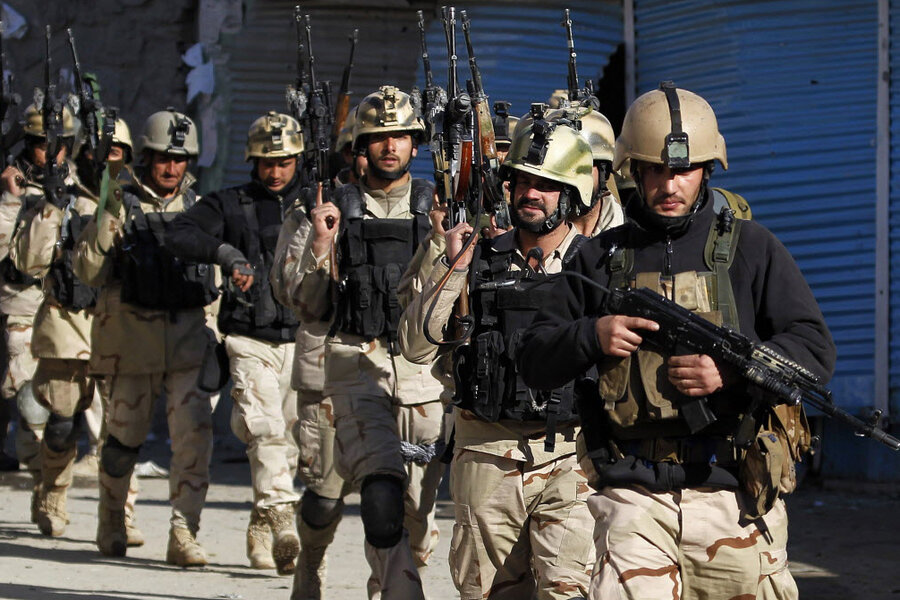Taliban suicide bombers target Afghan traffic police
Loading...
| Kabul, Afghanistan
Taliban suicide bombers carried out a brazen attack in the Afghan capital on Monday, the second in less than a week and a sign that insurgents are determined to keep fighting despite recent overtures of peace from the US and Afghan government.
The nine-hour assault on the traffic police headquarters, which sent heavy black smoke rising over Kabul, was the second such attack in the heart of the snow-covered capital in six days.
It came a week after the Afghan and American presidents agreed that the Taliban should open a political office in the Gulf state of Qatar to facilitate possible reconciliation with the hardline Islamic group. And it occurred just days after Pakistan announced it would release more Taliban detainees to help jumpstart the fragile peace process.
The pre-dawn attack began with two Taliban suicide bombers blowing themselves up at the gates of the police headquarters. Three heavily armed militants, also wearing explosive vests, then stormed the compound, authorities said.
About 90 minutes later, a car packed with explosives blew up near the gate. Such secondary explosive devices often are rigged to timers and designed to kill people responding to the attack.
The three militants who entered the compound battled Afghan security forces for nine hours. Three policemen were killed, said Interior Ministry spokesman Sediq Sediqi. Four traffic policemen and 10 civilians were wounded, he said.
Kabul Police Chief Gen. Mohammad Ayub Salangi said two suicide bombers died at the gate when they detonated their explosive vests, another blew himself up inside the building, and two more were shot and killed by security forces before they managed to detonate their suicide vests.
Taliban spokesman Zabiullah Mujahid claimed responsibility for the attack, which he said targeted a police training facility "run by foreign military forces."
The traffic police headquarters is not heavily guarded, though it is located on a square leading to the parliament and close to a zoo. It also is adjacent to the Afghan Border Police headquarters and a police training facility — possibly the insurgents' primary target. The traffic police facility, usually teeming with civilians seeking driver's licenses and vehicle registrations, was nearly empty when the attack began before the morning rush hour.
The Interior Ministry said many of the civilians were injured by the powerful car bomb. Some were in their homes and hit by shattered pieces of glass.
About two hours after the fighting ended, residents ventured out of their homes and shopkeepers arrived at the scene to see if their stores had been damaged. Two photo shops where people had driver's license pictures taken were nearly reduced to rubble. The explosions created a crater in the cement wall of the traffic police compound. Broken glass littered the street. One man shoveled shards into a wheelbarrow outside his damaged shop.
"We just stayed inside, waiting for it to end," said Fida Mohammad, who works at the Finance Ministry and lives just a few houses from the scene.
He said he was awakened by the explosions and car bombing. He and his family were not hurt, but a woman from a neighboring house was hit by a stray bullet, he said.
An Associated Press reporter at the scene said that during the fight a number of large explosions could be heard inside and around the building, along with heavy gunfire.
On Wednesday, six Taliban suicide bombers attacked the gates of the Afghan intelligence service in downtown Kabul, killing one guard and wounding dozens. That operation bore several similarities to Monday's attack, including the use of a secondary car bomb placed outside the government compound.
The attacks occurred despite the Afghan government's push to get the Taliban to the negotiating table and as President Hamid Karzai and the US negotiate for a quicker pullout of American forces.
After a meeting with Karzai earlier this month in Washington, President Barack Obama said the US-led military coalition would hand over the lead for security around the country to Afghan forces this spring — months ahead of schedule. Obama also said he agreed with Karzai that the Taliban should open a political office in Qatar to facilitate peace talks.
Moreover, Pakistan, a powerbroker in the region, said last week that it plans to release more Afghan militant detainees before international troops finish their drawdown in Afghanistan at the end of 2014. Islamabad made the announcement after talks with Afghan and U.S. officials in Abu Dhabi, the capital of the United Arab Emirates. Pakistan is thought to be holding more than 100 Taliban prisoners and has so far released 26.
Kabul has pressed hard for Pakistan to release Afghan detainees, with some officials saying that they hope the released Taliban can serve as intermediaries to help prospective talks gain traction. But Washington is worried that some of the detainees might rejoin the fight if released.
* Associated Press writers Rahim Faiez and Heidi Vogt contributed to this report.







